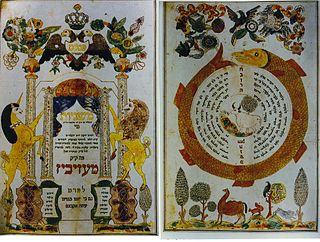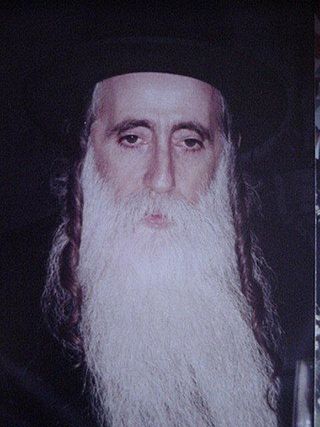
Rachmastrivka is a Hasidic dynasty named after the town of Rotmistrivka, Ukraine. It is an offshoot of the Chernobyl dynasty dating back to the 19th century.

Skver is a Chasidic dynasty founded by Rebbe Yitzchok Twersky in the city of Skver, or Skvyra, in present-day Ukraine during the mid-19th century. Adherents of the rebbes of Skver are known as Skverer Hasidim.

Chernobyl is a Hasidic dynasty that was founded by Grand Rabbi Menachem Nachum Twersky, known by the name of his work as the Meor Einayim. The dynasty is named after the northern Ukrainian town of Chernobyl, where Rabbi Nachum served as the maggid. The lineage has continued to exist to this day, although not always with the name Chernobyl. Today there are several rebbes named Chernobyl. The central court is in Bnei Brak, headed by Rabbi Menachem Nachum Twersky.
Biala is a Hasidic dynasty originating from the city of Biała Rawska, where it was founded by R. Yaakov Yitzchak Rabinowicz (II). Biala is a branch of Peshischa Hasidism, as R. Yaakov Yitzchak Rabinowicz (II) was the great-grandson of R. Yaakov Yitzchak Rabinowicz, the first Peshischa Rebbe. The dynasty was originally spread throughout many towns in Poland, often taking the names of said towns. However, after the Holocaust, the name "Biala" become synonymous with the entire dynasty. Today the dynasty is mostly concentrated in Israel, America and Switzerland.
Zvhil is the name of a Hasidic dynasty, with adherents today in Jerusalem, Boston, and New York.

Rabbi David Twersky, originally spelled Twerski, is the Grand Rabbi and spiritual leader of the village of New Square, New York, and of Skverer Hasidism worldwide.

Ohel is a structure built around a Jewish grave as a sign of prominence of the deceased. Ohelim cover the graves of some Hasidic Rebbes, important rabbis, tzadikim, prominent Jewish community leaders, and biblical figures. Typically a small masonry building, an ohel may include room for visitors to pray, meditate, and light candles in honor of the deceased.

The Apta-Zinkov-Mezibuz dynasty is a Polish Hasidic dynasty founded by Rabbi Avraham Yehoshua Heshel of Apta, born in Zhmigrid, Poland in 1748 and died in Mezhbizh, Ukraine, Russian Empire in 1825.

Kosov is the name of a Hasidic dynasty founded by Rabbi Menachem Mendel Hager of Kosiv, a town in Galicia, presently in Ukraine.

Mezhbizh is the name of the town of Medzhybizh in the present Ukraine which is significant as both the source of a Hasidic dynasty that bears its name and as a symbolic name for the roots of Hasidism.
Menachem Nochum Twersky of Chernobyl was a Ukrainian rabbi, and the founder of the Chernobyl Hasidic dynasty. He was a disciple of the Baal Shem Tov and the Maggid of Mezritch, and published one of the first works of Hasidic thought. He is considered one of the pioneers of the Hasidic movement.

Mordechai Twersky, known as Motele, was a Ukrainian rabbi. He was the son of Rabbi Menachem Nachum Twersky of Chernobyl and the second rebbe of the Chernobyl Hasidic dynasty. The family surname is Russian for "native of Tver", although Hasidic tradition connects it with the city of Tiberias. Unlike his father, who had lived frugally, he was known for requisitioning wealth from his followers. Seven of his eight sons were rebbes, from whom several branches of Hasidism emerged, including Skver, Chernobyl and Rachmastrivka.
The following charts illustrate the family of Rabbi Yisrael Baal Shem Tov, the founder of Hasidic Judaism.

Grand Rabbi Yehoshua Rokeach, the current Machnovka Rebbe of Bnei Brak, is a great-nephew of Rabbi Avraham Yehoshua Heshl of Machnovka, the third Machnovker Rebbe.
Hornosteipel is the name of a Hasidic dynasty founded by Rebbe Yaakov Yisroel Twerski. Hornosteipel is the Yiddish name of Hornostaypil, a town in present-day Ukraine.
Premishlan is a Hasidic dynasty. It was founded by Grand Rabbi Meir Hagadol of Peremyshliany
The Trisk dynasty is a Volyn Hasidic dynasty, a branch of the Chernobyl dynasty, originating in Turiisk, Ukraine. The rebbes of the court also served in Poland, before the Second World War it was a large court of some 20,000 Hasidim (followers).
Shpikov is a Hasidic dynasty originating in Shpykiv. The dynasty is derived from the Skver dynasty, which in turn is derived from the Chernobyl dynasty.
Hasidic Judaism in Poland is the history of Hasidic Judaism and Hasidic philosophy in Poland. Hasidic Judaism in Poland began with Elimelech Weisblum of Lizhensk (Leżajsk) (1717-1787) and to a lesser extent Shmelke Horowitz of Nikolsburg (Mikulov) (1726-1778). Both men were leading disciples of Dov Ber of Mezeritch (Medzhybizh), who in part was the successor to the Baal Shem Tov who founded Hasidic Judaism in Western Ukraine. Today, a sizable portion of contemporary Hasidic Judaism and Hasidic dynasties trace their genealogical and ideological origin to Polish Hasidism.
Rabbi David Leykes was a Hasidic Av Beit Din in the city of Bar and one of the disciples of Baal Shem Tov.










